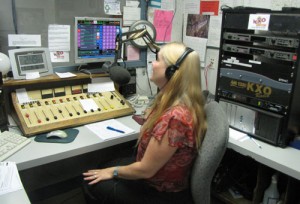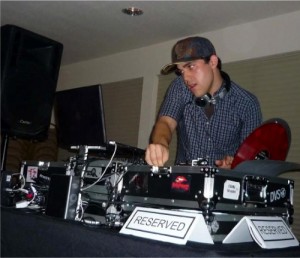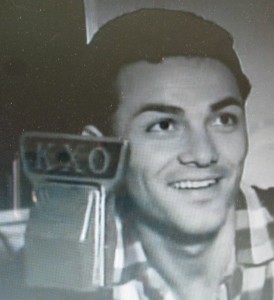The little red light on the sound board comes on and the microphone is live.
“Good afternoon, AM 1230 KXO. I’m Traci Lyon-Ramirez broadcasting. We’ve got some great stuff coming up for you this afternoon. It’s lunch time. Be careful while you’re on the road. It’s right here, AM 1230 KXO.” Lyon-Ramirez flips a switch on the audio board to dull the little red light, and “The Doors” sounds out over the airwaves.

Traci Lyon-Ramirez, on-air at KXO radio in El Centro, Calif., says that DJs live by the clock. "Everything has to be timed right so that there's no dead air." --Photo by Kaylene Sutton
KXO has been on air continuously since 1927 in the Imperial Valley, making it the longest-running radio station in this agricultural mecca of Southern California. Other radio stations have come and gone while KXO has persevered. Locally owned and operated, KXO radio broadcasts on both AM and FM frequencies. It’s the granddaddy of the few radio stations here.
Much like metropolitan radio, local radio has its stars and its loyal listeners, although it does not necessarily have the stability and longevity like large-city stations have, nor do the jobs in local radio.
The second oldest radio station in the valley, Brawley-based KROP 1300 AM, went silent in April 2010 after 64 years of country music and news/sports talk. Owner Cherry Creek Radio Corp. moved KROP’s sister FM station, Q96, to San Diego three months before and left KROP without the competitive advantage of a FM station. Consequently, Cherry Creek silenced the valley’s long-time sports, news and country station KROP.
“It’s sad, but the owners didn’t consider the community when they made this decision,” said Lyon-Ramirez, a 23-year veteran at KXO. Devout KROP listeners must now resort to other methods to get their country music fix. KPLM 106.1 FM, also called the Big 106, based out of Palm Springs 90 miles away, is now the only country radio station that reaches the Imperial Valley, and not always clearly.
Tony Driskill, station manager for KROP and Q96, is now running Q96 from Lake Tahoe, California. Q96 has no disc jockeys in the studio, nor any commercials to interrupt the music. According to Driskill, “It’s all music all the time.”
“In a good month, Q96 would bring in about $100,000 in Brawley,” Driskill said. “In San Diego, it has the potential to make six times that amount.” He estimates that if the station were sold in Brawley, it would have been worth $5 million. In San Diego, it has the potential of selling for $20 million.
But, that doesn’t answer why KROP had to be silenced. “I think the owners made the decision thinking that it would only be off for two days to a week,” explained Driskill. “I don’t think they planned on it being off for this long.”
“There are only so many radio stations,” Lyon-Ramirez said. “Nobody else can go back into Brawley and start a radio station; (Cherry Creek) took the signals. It’s hard for small towns when they do that. I mean, did San Diego really need another radio station?”

Alex Sykora, also known as DJ Arox, puts together a mix with his disc jockey equipment. Sykora says that he's invested thousands of dollars into his equipment over the years. --Photo by Kaylene Sutton
Only five radio stations are licensed in the Imperial Valley, which makes livelihoods in the industry here hard to nurture.
“The problem is radio is kind of dying out,” said disc jockey Alex Sykora, also known as DJ Arox. “It’s a combination of the Internet age and the fact that there are now more mediums to listen to music with.” Sykora has nine years of DJ experience. He specializes in live shows, although he got his start jockeying at Q96 before he started a nursing education at Imperial Valley College in Imperial.
“I’m going to school for nursing,” says Sykora. “I want a job that actually makes money, something consistent. The entertainment business is too shaky.”
But, Sykora said he loves the live action of radio and private DJ gigs. “I love sharing music with people,” Sykora said. “When the crowd gets going, it feels like I’m hearing the song for the first time.”
Live private shows for local bars, parties and other events are where most music DJs make their money—not in radio.

Rafeal Moreno, or 'DJ RM in the AM,' was a featured disc jockey at Club Envy in Brawley, Calif. before its closure at the beginning of the year. --Poster art provided by G2design
“I was always very passionate about music and liked to share it with other people,” says Rafael Moreno, who worked at Q96 before it was moved to San Diego County. Then he moved to Power 98 in Mexicali. “It can be an art form and a science to me because you have to learn a lot about electronic equipment, recording, mixing. There are a lot of little details that go into those things.”
Moreno, or as he’s called at the Power 98 station, “DJ RM in the AM,” performs both live shows and on the radio. “I prefer live shows because I get to see my audience,” he said. “But in the radio booth, I get to speak a little bit more. I like getting information out to the public and being entertaining for them.”
Performing live shows comes at a cost. DJs who perform live usually have to buy their own equipment, which can cost about $8,000. “Music costs a lot now,” says Sykora. “Some DJs bootleg or pirate, but if you want the quality sound, you’re going to pay for the track.”
As far as radio old-timers are concerned, the private party circuit and even the Internet will not outlive the traditional information and entertainment of radio.
Norman Germani, 82, a radio announcer for KXO from 1951 to 1955, refuses to believe radio—local or otherwise—will succumb to the Internet.
“After a windstorm here 60 years ago, TV antennas would get knocked over and people would tune into their radio for the news,” Germani said. “It’s not much different today. If you lose your Internet, and you will, well, we did in the earthquake, but we had our battery-powered radios for information.”

Norman Germani as a KXO radio announcer in 1952, El Centro, Calif. “The next time a big earthquake hits, do you really think you’ll turn into the Internet when you have no electricity to power your computer or your cell phone?” --Photo Courtesy of Germani Family
But long-time valley radio leader, KXO, was knocked off the air during the Easter Sunday 2010 7.2-magnitude earthquake that violently shook the valley and upper Baja.
“If KXO plays its cards right, they’ll get that auxilliary generator they should have had during the earthquake,” Germani said. KXO reportedly did not have a back-up generator to counter the power outages leveled by the quake. Consequently, information about the quake was lax for several hours.
“The next time a big earthquake hits, do you really think you’ll turn into the Internet when you have no electricity to power your computer or your cell phone or cell tower?” Germani posed. “No, you’ll find a radio to get the news. That’s why radio is superior to the Internet.”


I’m proud of you, Kaylene!
wow kxo rideo has been around for a long time now since 1927 thats a long time